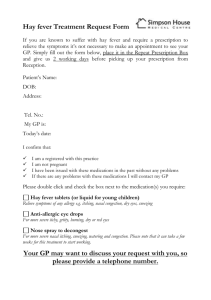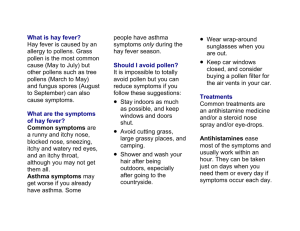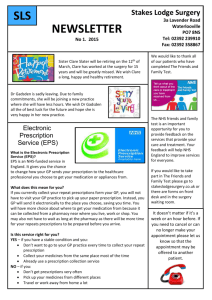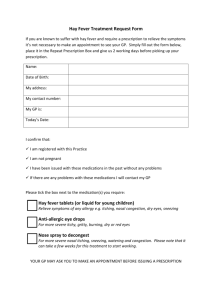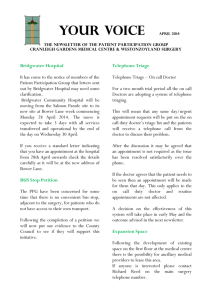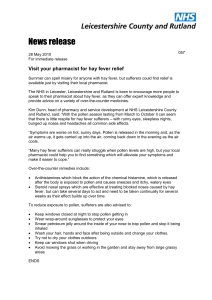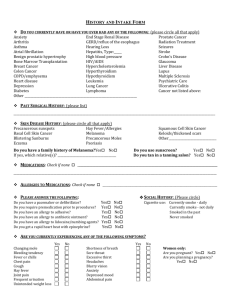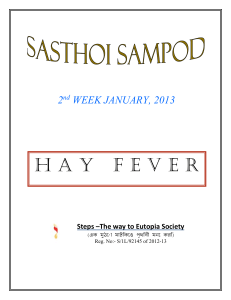Hay Fever (Allergic Rhinitis)
advertisement
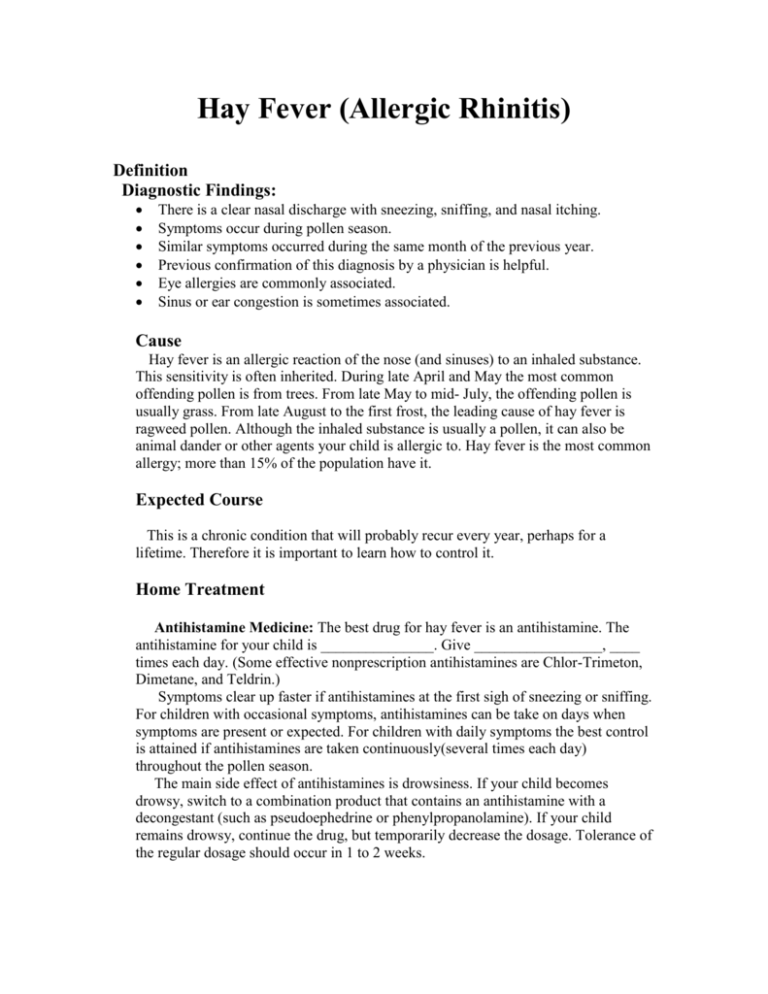
Hay Fever (Allergic Rhinitis) Definition Diagnostic Findings: There is a clear nasal discharge with sneezing, sniffing, and nasal itching. Symptoms occur during pollen season. Similar symptoms occurred during the same month of the previous year. Previous confirmation of this diagnosis by a physician is helpful. Eye allergies are commonly associated. Sinus or ear congestion is sometimes associated. Cause Hay fever is an allergic reaction of the nose (and sinuses) to an inhaled substance. This sensitivity is often inherited. During late April and May the most common offending pollen is from trees. From late May to mid- July, the offending pollen is usually grass. From late August to the first frost, the leading cause of hay fever is ragweed pollen. Although the inhaled substance is usually a pollen, it can also be animal dander or other agents your child is allergic to. Hay fever is the most common allergy; more than 15% of the population have it. Expected Course This is a chronic condition that will probably recur every year, perhaps for a lifetime. Therefore it is important to learn how to control it. Home Treatment Antihistamine Medicine: The best drug for hay fever is an antihistamine. The antihistamine for your child is _______________. Give _________________, ____ times each day. (Some effective nonprescription antihistamines are Chlor-Trimeton, Dimetane, and Teldrin.) Symptoms clear up faster if antihistamines at the first sigh of sneezing or sniffing. For children with occasional symptoms, antihistamines can be take on days when symptoms are present or expected. For children with daily symptoms the best control is attained if antihistamines are taken continuously(several times each day) throughout the pollen season. The main side effect of antihistamines is drowsiness. If your child becomes drowsy, switch to a combination product that contains an antihistamine with a decongestant (such as pseudoephedrine or phenylpropanolamine). If your child remains drowsy, continue the drug, but temporarily decrease the dosage. Tolerance of the regular dosage should occur in 1 to 2 weeks. Good News: Severe hay fever can now usually be controlled by new cromolyn or steroid nasal sprays rather than allergy shots. Since these sprays must be used when the nose is not dripping, antihistamines must be given first to stop the drainage. Pollen Removal to decrease symptoms of Hay Fever: Pollen tends to collect on the exposed body surfaces and especially in the hair. Shower you child and was his/ her hair every night before going to bed. Avoid handling pets that have been outside and are probably covered with pollen. Prevention Of Hay Fever Symptoms: Your child’s exposure to pollen can be reduced by not going on drives in the country, not sitting by an open car window on necessary drives, not being near someone cutting the grass during pollen season, staying indoors when it is windy or the pollen count is especially high, and closing the windows that face the prevailing winds. If your child’s hay fever is especially bad and you don’t have air-conditioned store or theater for a few hours. Avoid feather pillows, pets, farms, stables, and tobacco smoke if any of them seem to bring on symptoms of nasal allergy Eye Allergies Associated with Hay Fever: if your child also has itchy watery eyes, wash the face and eyelids to remove pollen. Then apply a cold compress to the eyelids. Also instill 2 drops of long-acting vasoconstrictor eye drops every 8 to 12 hours (a nonprescription item). Ask your pharmacist for help in choosing a reliable product. Common Mistakes: Vasoconstrictor nose drops or nasal sprays usually do not help hay fever because they are washed out by nasal secretions as soon as they have been instilled. Also, when used for more than 5 days, they can irritate the nose and make it more congested. CALL OUR OFFICE (623)556-KIDS(5437) During Regular Hours if: The Treatment does not relieve most of the symptoms. The secretions become thick yellow for more than 24 hours. Your child develops sinus pain or pressure. Your child is missing any school, work, or social activities because of his/her hay fever. The hay fever keeps your child from playing or sleeping You have other concerns or questions
